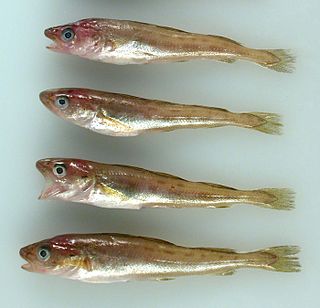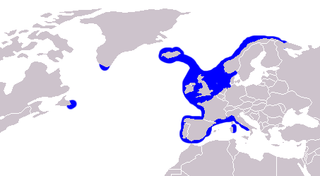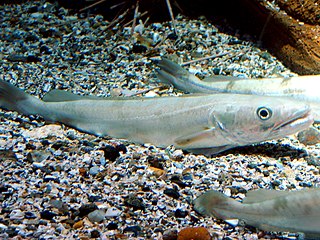
Boreogadus saida, known as the polar cod or as the Arctic cod, is a fish of the cod family Gadidae, related to the true cod. Another fish species for which both the common names Arctic cod and polar cod are used is Arctogadus glacialis.

Arctogadus glacialis, known also with ambiguous common names Arctic cod and polar cod, is an Arctic species of fish in the cod family Gadidae, related to the true cod. Arctogadus glacialis is found in icy water. They grow to about 30 cm long, and are favorite food of narwhals and other arctic whales.

The saffron cod(Eleginus gracilis) is a commercially harvested fish closely related to true cods. It is dark grey-green to brown, with spots on its sides and pale towards the belly. It may grow to 55 cm and weigh up to 1.3 kg.

The navaga is a relatively small species of fish in the cod family Gadidae. It inhabits the European arctic and subarctic waters of the Barents, White, and Kara Seas, from the Kola Bay to the Ob River estuary.

The common ling, also known as the white ling or simply the ling, is a large member of the family Lotidae, a group of cod-like fishes. It resembles the related rocklings, but it is much larger and has a single barbel. This species is unrelated to the pink ling, Genypterus blacodes, from the Southern Hemisphere. The common ling is found in the northern Atlantic, mainly off Europe, and into the Mediterranean Basin. It is an important quarry species for fisheries, especially in the northeastern Atlantic, although some doubts exist as to the sustainability of the fisheries. As an edible species, it is eaten fresh, frozen, or dried, but also preserved in lye, while the roe is a delicacy in Spain.

The silver hake, Atlantic hake, or New England hake is a merluccid hake of the genus Merluccius, found in the northwest Atlantic Ocean. It is highly predatory and typically feeds on fish and crustaceans.

The shore rockling is a mottled brown, small, elongated fish. This eel-like fish has three barbels on its head, with the second dorsal fin and the anal fin running the length of most of its body. These fins may be viewed moving in a continuous wave motion.

Gadella is a genus of morid cod. The species in this genus are characterised by the absence of a chin barbell, an anterior dorsal fin with 7-11 rays, a long based anal fin which has a straight profile, the outermost rays of the pelvic fin are filamentous and extend a small distance beyond the membrane. They do not have a photophore. The Gadella codlings are found around the tropical and subtropical seas around the world on the outer continental shelf to the mid continental slope. They are of no interest to fisheries.

Merluccius merluccius, the European hake, is a merluccid hake of the genus Merluccius. Other vernacular names include Cornish salmon and herring hake. It is a predatory species which was often netted alongside one of its favoured prey, the Atlantic herring, thus the latter common name. It is found in the eastern Atlantic from the Norway and Iceland south to Mauritania and into the Mediterranean Sea. It is an important species in European fisheries and is heavily exploited with some populations thought to be being fished unsustainably.

Merluccius capensis is a ray-finned fish in the genus Merluccius, found in the south-eastern Atlantic Ocean, along the coast of South Africa. It is a long, lean fish with a large head, similar in appearance to the European hake and the deep-water Cape hake. By day, it lives close to the bottom on the continental shelf and upper slope at depths not usually exceeding 400 m (1,300 ft); it makes a large, daily vertical migration rising at night to feed in the nectonic zone, and it also migrates southwards in spring and northwards in autumn. It is an important commercial fish species in southern Africa.
Merluccius paradoxus, the deep-water Cape hake, is a merluccid hake of the genus Merluccius, found in the south-eastern Atlantic Ocean, along the coast of Southern Africa, south of Angola. Its range extends in decreasing abundance around the southern coast of Africa and into the Indian Ocean, but it is at its most plentiful in the cold, nutrient-rich fishing grounds of the Benguela Current.

Trisopterus is a genus of small cods, family Gadidae. They are native to the northeastern Atlantic Ocean including the Mediterranean Sea.

Trachyrincus scabrus, the roughsnout grenadier or Mediterranean longsnout grenadier, is a species of bathydemersal marine fish from the subfamily Trachyrincinae, part of the family Macrouridae. It is found in the eastern Atlantic Ocean and the Mediterranean.
Merluccius australis, the Southern hake, is a species of fish from the family Merlucciidae, the true hakes. It is found in the southern Pacific and Atlantic Oceans with two disjunct populations, one around southern South America and the other in the waters around New Zealand.
Merluccius hernandezi, the Cortez hake, is a species of fish from the family Merlucciidae, the true hakes. It is endemic to the Gulf of California where it can be found in the epipelagic and mesopelagic zones over the continental shelf, open sea, and sea mounts, to a depth of around 300m. It is a small species which has been referred to as a "dwarf hake" and is of little interest to fisheries, other than small scale local fisheries. It was described in 1985 and small hake in the Gulf of California were previously considered to be Panama hakes. This species differs from the Panama hake in that in juveniles the caudal fin has a central lobe and is truncate in adults, whereas the caudal fin is emarginate in the Panama hake, its pectoral fin projects well beyond the anus in but does not do so in the Panama hake.
Merluccius polli, the Benguela hake, is a species of fish from the family Merlucciidae, the true hakes. It is found in the tropical waters of the eastern Atlantic Ocean off the west coast of Africa.
Merluccius senegalensis, the Senegalese hake, is a species of fish from the family Merlucciidae, the true hakes. It is found in the sub tropical waters of the eastern Atlantic Ocean off the north western coast of Africa.

Gadella maraldi, the gadella or morid cod, is a species of fish in the family Moridae from the warmer waters of the north eastern Atlantic Ocean and the Mediterranean Sea.
The spearsnouted grenadier is a species of fish in the family Macrouridae.
Lyconus brachycolus is a species of hake fish in the family Merlucciidae.













